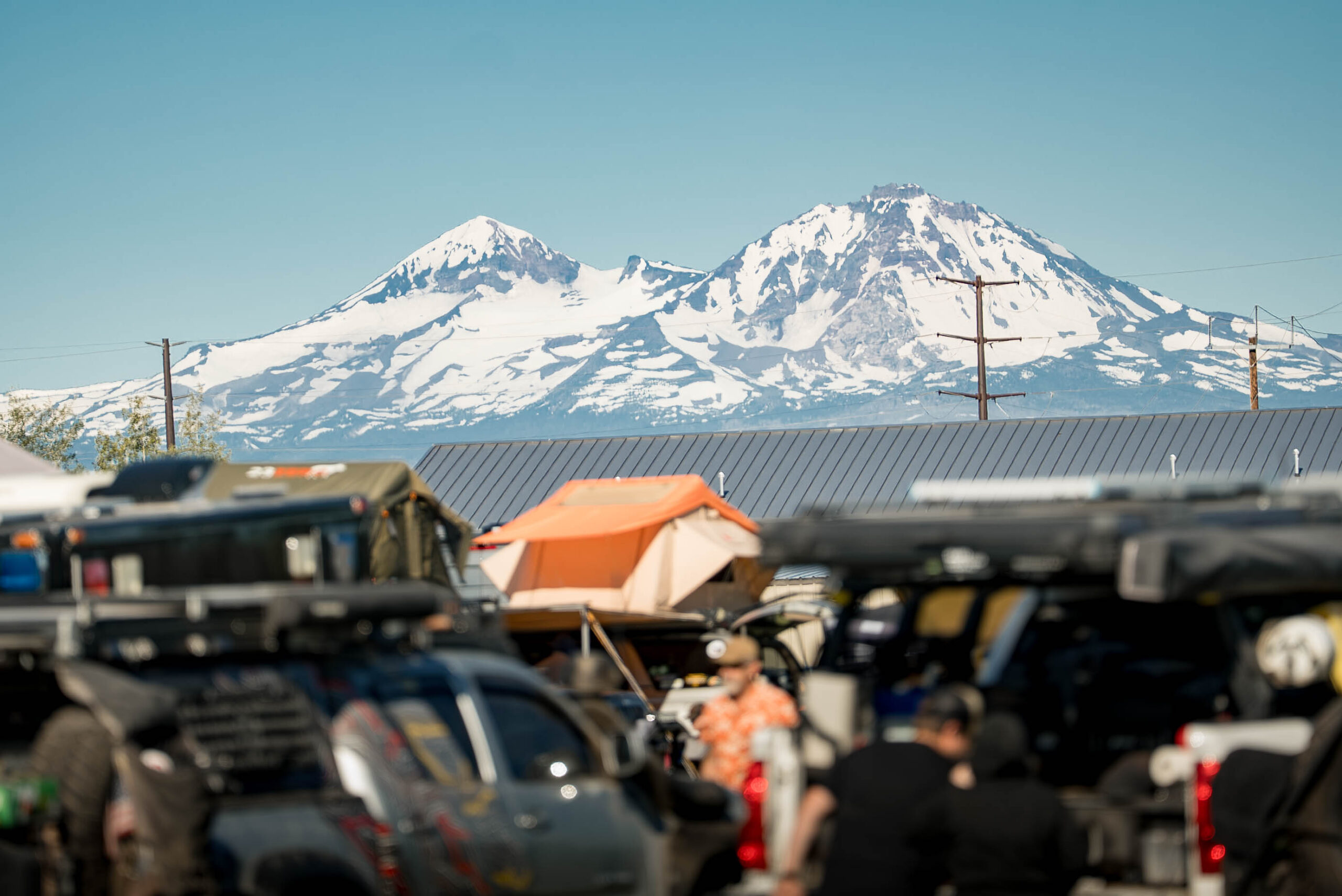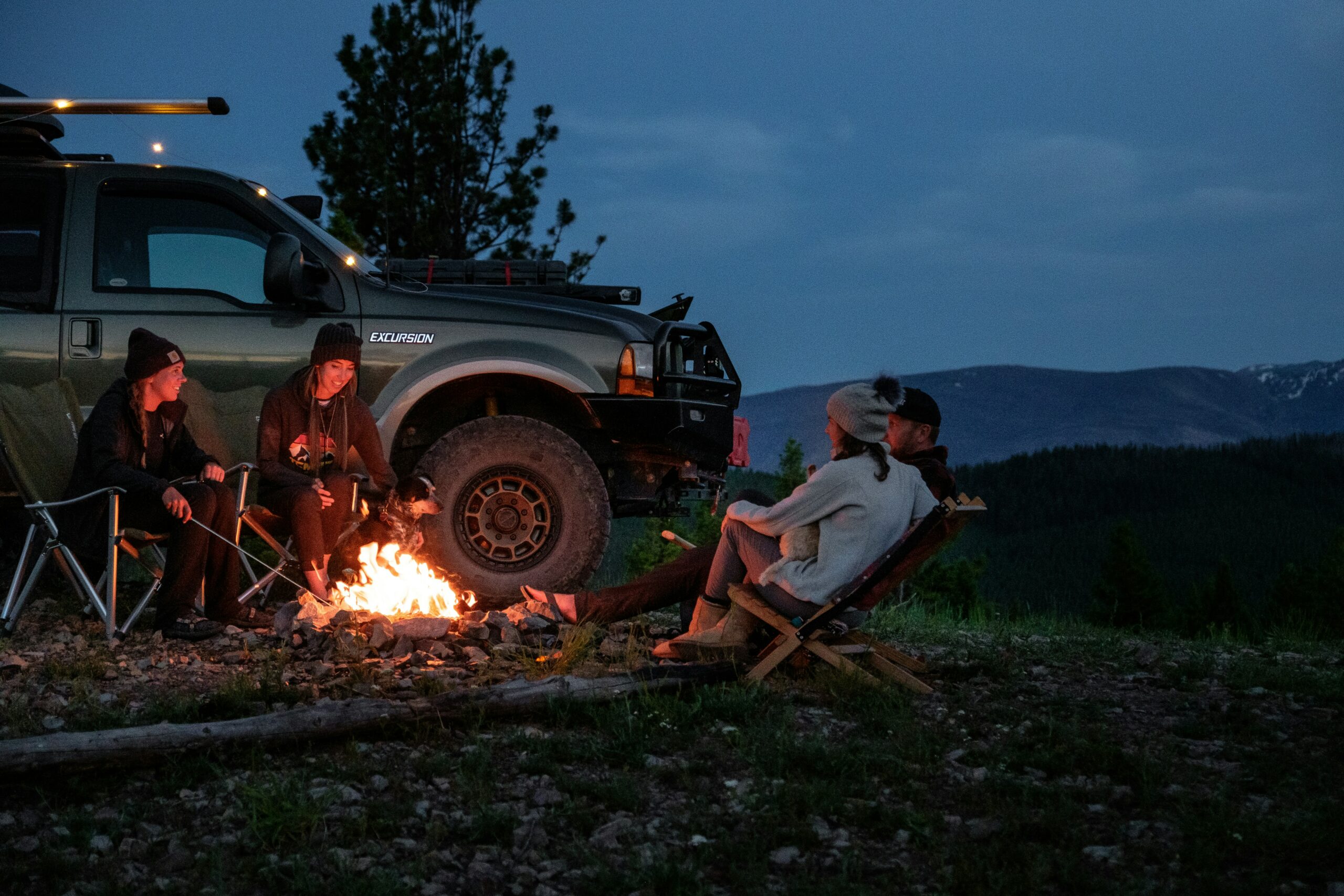Takeaway: India’s Royal Enfield has joined the modern adventure bike ranks with a surprisingly capable, powerful, and comfortable new model in the Himalayan 450. The complaints against its predecessor, the 411 Himalayan, have been addressed and then some. A powerful new motor, real-world Showa off-road suspension, genuine off-road capability and excellent highway comfort at an almost laughably low price should put the competition on notice.
William Roberson
The big adventure riding question is this: Brands and egos aside, just how big, how fancy, how expensive, and ultimately how capable does an adventure motorcycle need to be to safely and comfortably get you to where you want to go, no matter where on Earth that place may be? It’s both a simple and complicated question, with an unlimited amount of debate, argument, and disagreement built in.

For many adventure motorcycle riders, and especially a motorcycle journalist like myself who is lucky enough to get seat time on a wide variety of motorbikes, there are those rare moments when you say or think to yourself while riding: “Oh wow, this is it. I could go anywhere on this thing.” On a recent North American press ride on the new Royal Enfield 450 Himalayan, I and several other riders had that kind of moment. I know this because we talked about it after nursing our wounds from the press ride – and there were actual wounds for some of us.
Tech and Design
The new Himalayan 450 is not mechanically related to its predecessor and stablemate, the 411 Himalayan. Introduced in 2016, the 411 “Himmie” is based on a dependable but underpowered (outside of India) air-cooled 411cc single that can barely do the legal speed limit when ridden flat out on many U.S. highways. The loveable 411 is nonetheless a popular choice for budget adventure riding due to its simplicity, ruggedness, and low price. It is a backroads pack mule, and it remains in the lineup – for now.
The new Himalayan 450 addresses pretty much every shortcoming of the venerable 411. It retails for $5,799 in base trim form, and there are three trim options built on the base platform. For all the variants, all specifications are identical except for weight due to accessories.

The bikes started out shiny and clean. They would not stay that way for long. Photo by William Roberson

Muddies, crashed but ready to ride. One tough bike. Photo by William Roberson
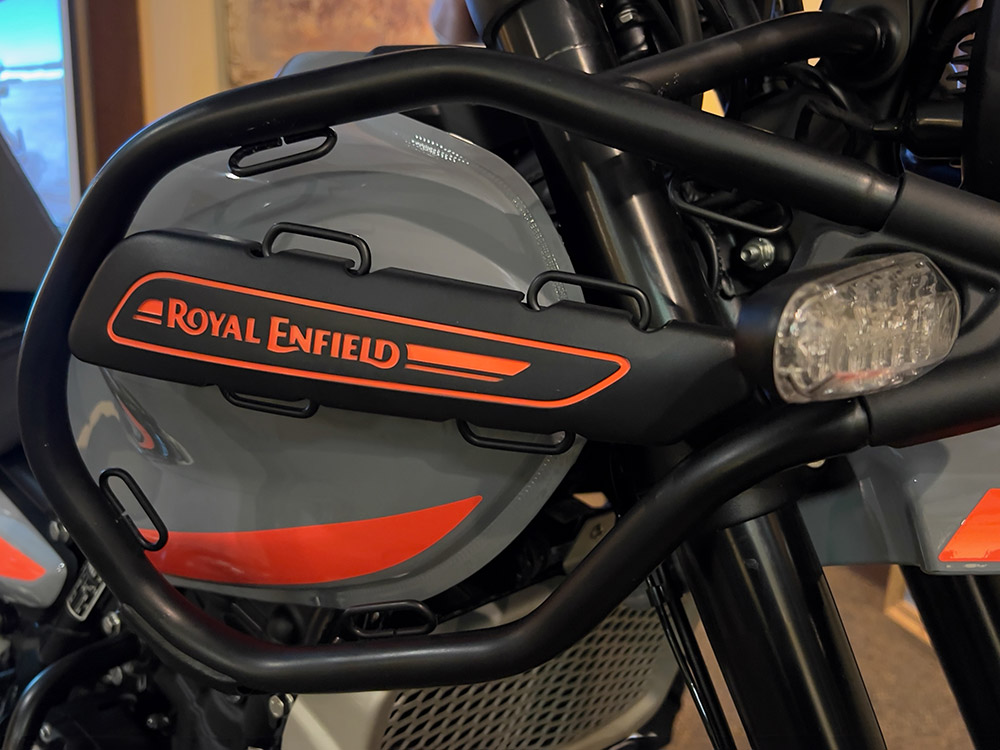
Photo by William Roberson

Photo courtesy of Royal Enfield

Photo courtesy of Royal Enfield

Photo courtesy of Royal Enfield

Photo courtesy of Royal Enfield
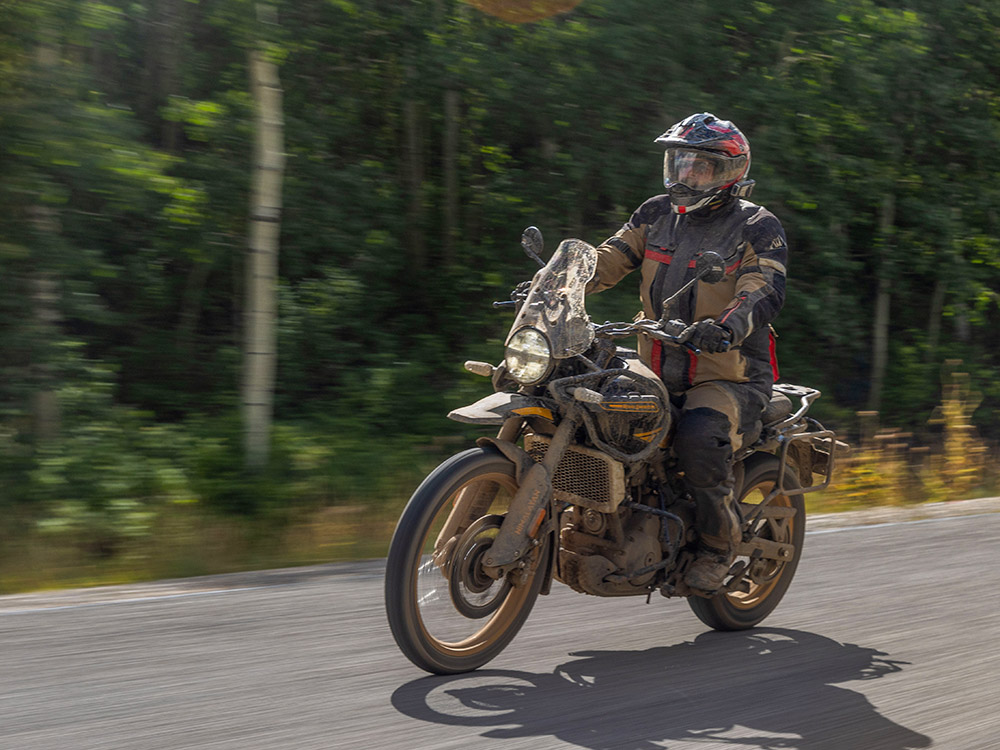
Photo courtesy of Royal Enfield
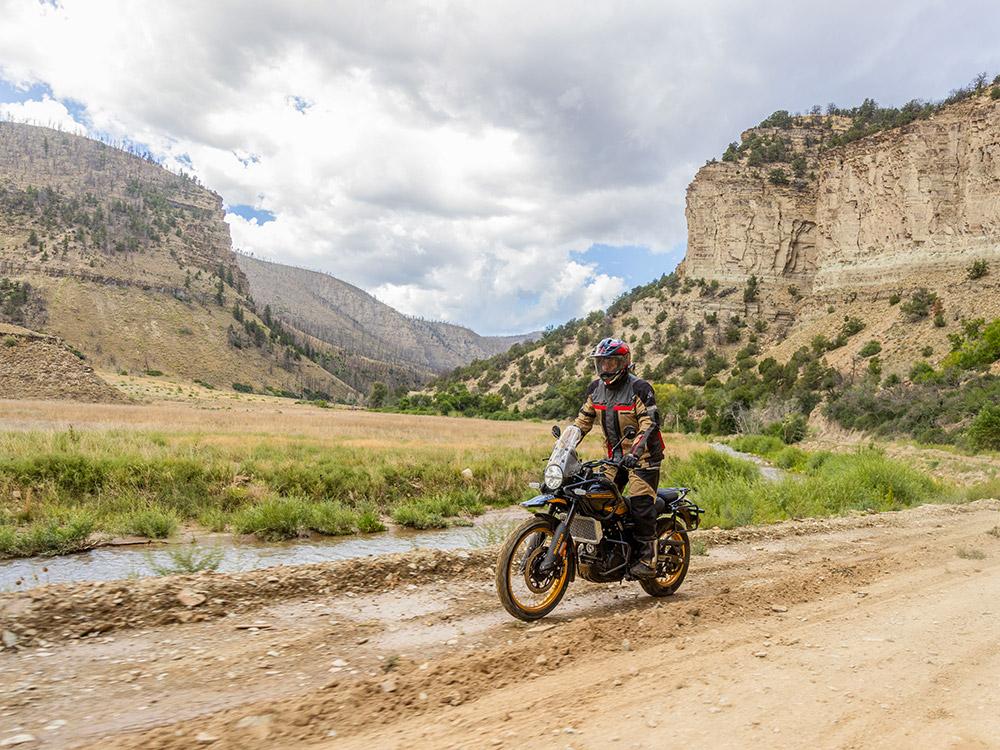
Photo courtesy of Royal Enfield
Royal Enfield, founded as a motorcycle maker in 1901 in the UK and now based in India, has only made air-cooled motors until this model. The Himalayan 450’s new “Sherpa” engine is a clean-sheet, 4-valve, 452cc liquid-cooled fuel-injected single that produces 40 horsepower at 8,000 rpm – up 12 horsepower on the 411. Redline is a lofty 9,000 rpm, compression a stout 11.5:1. Torque is 40Nm/30 lb-ft at lower rpms, up about six from the 411. The Sherpa spins a new six-speed gearbox and is controlled by a ride-by-wire throttle. For comparison, the Honda CRF450RL makes 38 horsepower at 7,500 rpm and 27.8 lb-ft of torque at 6,400 rpm. It also costs $10,099.
READ MORE: Overland Expo Presents the Overland Expo Film Festival Lineup for East 2024
A Harris Performance-designed steel tube frame carries an adjustable rear Showa mono-shock and non-adjustable 43mm Showa USD forks, both with 7.9 inches of travel. Single Brembo “ByBre” disc brakes grace both wheels, and the dual-channel ABS can be switched off to the 17-inch rear wheel while ABS sensitivity is reduced to the 21-inch front hoop, but it cannot be turned off completely due to regulations in some markets. Ground clearance is 9 inches, and weight comes in at 432 pounds fueled for travel, about 10 pounds less than the 411, even with the bigger 4.5-gallon tank nearly topped up.

The 450’s modernization continues in the cockpit. A 4-inch circular color “Tripper Dash” TFT screen (above) can show detailed Google Maps when paired to a smartphone and the Royal Enfield app. It can also show phone ops, music information, and a simple analog/digital mix of tachometer and speedometer as shown. The current speed is always displayed across all modes. A small left bar pod joystick and buttons on the right pod control the Tripper’s display while stopped, with reduced functionality when in motion. It is not a touchscreen.
Riders can switch between Eco and Performance ride modes and toggle ABS, but only while stopped. Two trip meters, both real-time and average fuel economy, and a few other metrics can also be shown, including a range-to-empty estimate for the 4.5-gallon tank, which Royal Enfield says will provide well over 200 miles of range from the thrifty 450. There is a gas gauge in the center of the display. Stout metal crash bars on each side of the bulbous gas tank come standard and feature mounting points for gear. There’s LED lighting all around, and the turn signals function as brake lights. The 450 rolls on wire spoke wheels that require tubes, but wheels that allow tubeless tires are in the works for the near future.
Ride Time
The day spent riding the new Himalayan 450 on and off-road through high-elevation locations in Utah’s scenic BDR backcountry started off pretty much by the numbers, and then quickly became a challenging skills test for all involved. Many riders, self-included, ended up on the ground at some point, some more than once, and a few riders came away with minor injuries, thankfully none too serious. Everyone got very, very muddy and generally very sore. Adventure riding can be a solid workout.

Photo courtesy of Royal Enfield

Photo courtesy of Royal Enfield

Photo courtesy of Royal Enfield

Photo by Gabe Dilla
We began with an easy, scenic stretch of highway riding along Route 40 under mostly sunny skies, and initial impressions were favorable; the Himalayan 450 is very much at home on the open road, and most importantly, it’s plenty fast, with a top speed reportedly in excess of 100 mph and actual passing power on tap. I was able to easily dial up 90 mph and that was at close to 10,000 feet in altitude with a large, heavy rider (me) aboard. Quite an improvement over the old 411, which could barely manage 75 mph flat out at sea level. Blowing down the highway well above the legal limit, the 450 was calm, comfortable, and not hyperventilating like the 411 can at maximum effort. To me, it felt similar (but better) than my trusty Suzuki DR650SE. There’s a small bit of buzz in the pegs and bars at higher RPMs, and we had taken the rubber comfort pucks out of the pegs since off-road excursions were on tap.
Soon, we turned onto a graded dirt road that snaked along a river for some photo passes. Thunderheads began to rumble nearby, and it was at this point that many of the riders realized our presently shiny, clean Himalayan 450s were riding on stock-from-India CEAT Gripp Rad 80/20 tires with the barest of siping. They had decent grip on the short stretch of dry and flat-graded dirt road we were on, but as a thunderhead passed over and raindrops began pelting down, many of us began to wonder how the tires would cope with actual mud. We quickly found out.
After crossing a wide but not too deep stream as rain showered down, my front wheel caught the edge of a deep puddle, and with the clay-heavy Utah soil now slippery as ice, traction disappeared instantly. The front end washed out, and down I went (below). Unhurt except for a skinned elbow and my pride (thanks, Tour Master Mariner gear), I popped up immediately, righted the 450, and remounted. The brake pedal was bent sharply upward from the crash, but I simply stood on the mild steel lever, and it bent back into a usable position – for the most part. Later, when I asked how much a new one might cost, I was told $20. That’s quite reasonable and is a good example of Royal Enfield’s ethos of making certain parts that can be bent back into place while riding or replaced for minimal cost later on.

The bike features automatic engine kill in a crash, so I cycled the key, clicked into gear, and gassed the 450 to catch up with my group. On a dry, relatively straight, and flat Jeep/OHV road, I made good time, the surprisingly compliant and well-damped Showa suspension soaking up the bumps and returning a feeling of control and confidence. Miss a shift and it’s no problem, as a slipper clutch is standard.
Up ahead, I saw the rider ahead of me nearly get bucked off his 450 as he encountered a deep but hidden rut across the trail at speed. Still going in a straight line, I put trust in the ABS, grabbed a lot of front brake, added in some skidding non-ABS rear brake, and then released them as I neared the small gully to let the suspension have full travel.
The impact used up pretty much all of the Showa’s eight inches of front suspension travel, but I had slowed just enough, and the 450 remained in control despite the big hit. I dialed back the speed for safety’s sake and still made good time, enjoying the capable 450 on mostly open-range, dry dirt roads threading through beautiful canyons and mountain-top scenery. Then things got technical. And very, very muddy.

Our lunch stop was set for a campground well above 9,000 feet in elevation, and thunderstorms crossing the mountains had left behind numerous slick sections, often with deep mud puddles. Ascending the steep, rutted, technical passage to the rest stop, the 450 Himalayan capably navigated ruts, roots, rocks, and other obstacles while the tires fought for purchase, especially around the edges of deep, lane-spanning puddles. Some puddle ponds I could go around, others left no choice but to power through (above).
Riding alone on a downhill section close to the lunch stop, I crossed a large, muddy, puddle-strewn section that immediately clogged the CEAT’s meager tread, and while I stayed upright, the Himalayan 450 slid and shimmied while crossing the morass. The spot later claimed numerous riders, including one who suffered a ride-ending impact to her knee as she and others crashed en masse. Most of us ate our box lunches quietly, winded from the effort to navigate the demanding route at such high elevation – and mindful there was more to come. The bikes – and most riders – were completely coated in mud. Some riders poured brown water out of their boots or wrung out drenched riding gear. But still, there were a lot of tired (and muddy) smiles from the riding experience so far – for most of us.

Photo courtesy of Royal Enfield

Photo courtesy of Royal Enfield

Photo courtesy of Royal Enfield
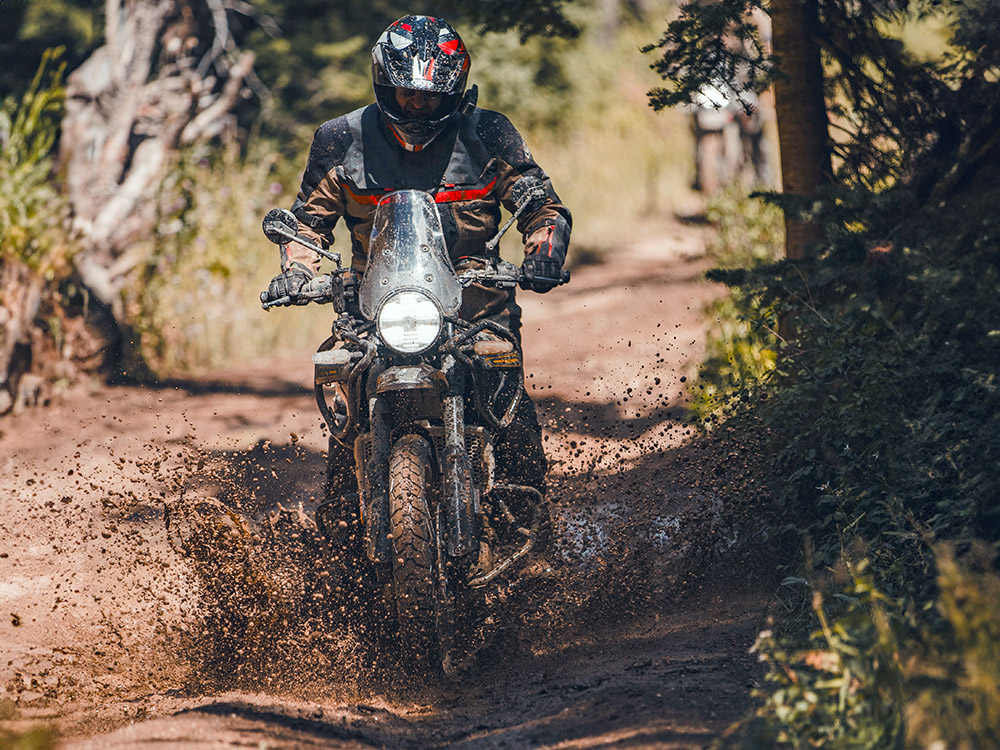
Photo courtesy of Royal Enfield
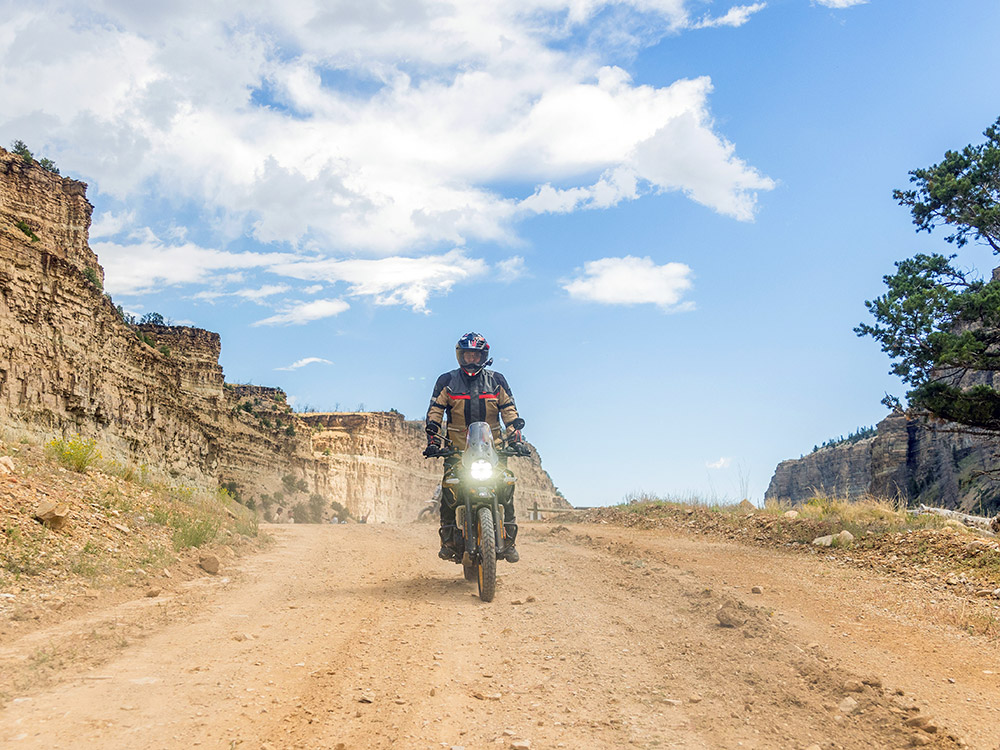
Photo courtesy of Royal Enfield
After lunch, we picked our way through several more challenging slow-speed technical sections and mud bogs (above) that had more Himalayans and riders having close encounters with Mudder Earth. But on balance, the 450 was proving to be an unexpectedly capable adventure bike, with a friendly but powerful engine, well-sorted suspension, and a solid, confidence-inspiring controllability. A simple change in tires would have likely solved the traction deficit in the muddy bits.

Photo by William Roberson

Photo by William Roberson

Photo by William Roberson

Photo courtesy of Royal Enfield
Finally, we reconnected with pavement, cleaned our visors (and goggles, glasses, faces, and Tripper displays) as best we could, put the bikes into Performance mode with full ABS, and began strafing a long series of sweepers on a winding, traffic-free stretch of smooth, grippy pavement (above). The CEAT skins were now in their element, and the 450 Himalayan makes for a surprisingly agile – and rapid – road ripper, nearly touching 100mph on straight sections even with my none-too-small corpus working like a leaden sail against it. At or above the speed limit, the Himalayan 450 is relaxed, placid, and surprisingly roomy, the new engine ticking down the road in sixth gear and netting over 60mpg, according to the Tripper readout.
Conclusions
It’s easy to imagine loading the Himalayan 450 with different tires and enough gear for a long, long ride to some far-flung Point B (and C and D and so on). Of course, Royal Enfield has a deep ADV touring catalog of add-ons, including hard and soft panniers, crash bars, windscreens, seat options, and more to build out a 450 for such adventures. With the new Sherpa engine, they’ve brought the performance and velocity capabilities up to modern (and competitors’) standards as well. The new engine is also the centerpiece of a new road bike, the Guerilla, and we can expect more liquid-cooled power from Royal Enfield’s thoroughly modern R&D and manufacturing facilities as well. And like most every Royal Enfield motorbike, toughness, roadside repairability, and longevity is the priority over pure performance, so much so that the 450 comes with a three-year unlimited mileage warranty.
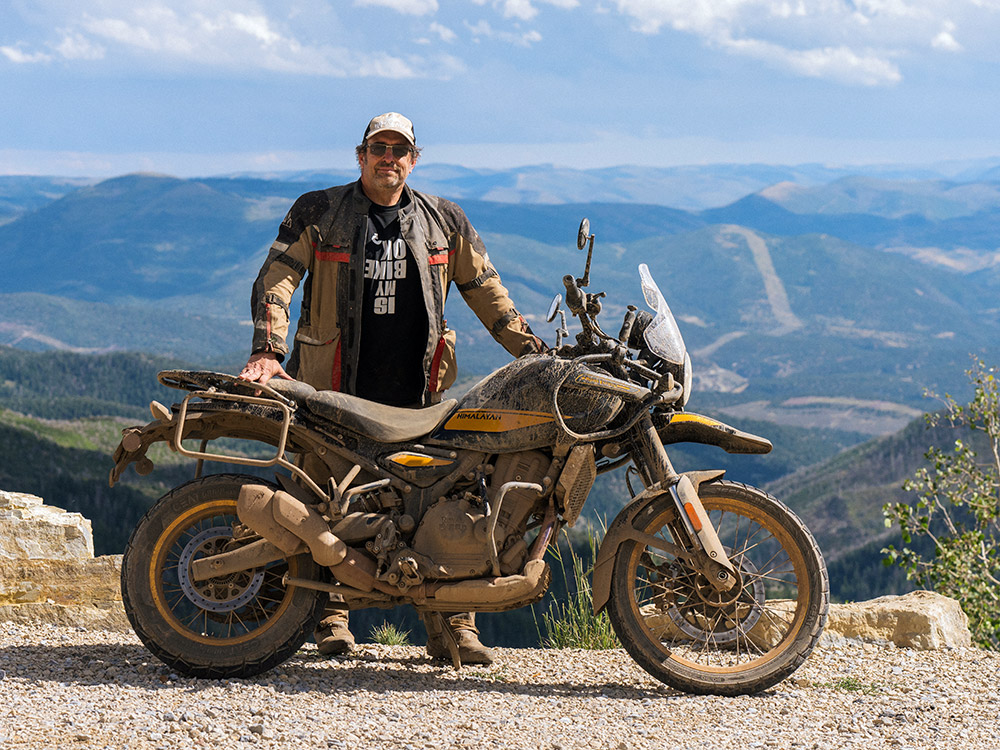
For the base price of much of the 450/500cc competition, riders can buy and outfit a Himalayan 450 with a wide range of adventure gear that will enable pointing the bike to any corner of the globe and setting off on a grand adventure – and it will most likely get them there with little fuss or complaining. With a different set of tires, epic adventures are suddenly within reach on a robust, comfortable machine that packs efficiency, useable tech, high-level off-road capability, and bend-don’t-break toughness in an affordable, attractive package.
It really goes back to Those Questions: How much adventure bike do you really need? If adventure riding is about being seen on a certain brand, displacement, or having the latest tech, the Himalayan 450 will probably fall short. But if your itch is to get out there and see the world, brand be damned, the $5,799 450 Himalayan offers a surprising – even borderline shocking – good value that ties together capability, affordability, and just all-around fun riding both on the road and well off of it. That is why I bought a Suzuki DR650 almost two decades ago: It’s tough, simple, and capable (and remains so today).
Riding the new Himalayan 450 was a very similar – but better – experience. Indeed, Royal Enfield principals, including bike designers who were on the ride with us, said they took inspiration from “simple” dual-sport machines like the DR, KLR, and Honda’s venerable XR650L. But the 450 is lighter, about as powerful, more comfortable, and much better handling, and includes just enough useful tech, especially the EFI, ABS, traction control, two ride modes, and Tripper display with mapping capability. And we really beat the crap out of them, yet every bike save one from an injured rider was ridden back to the base (hotel) camp, muddied, a bit dinged up, but ready to go again the next day with some minor repairs and a quick wash.
I feel you truly can go anywhere on this thing, and that’s why I’m replacing my aging DR650SE with the new Royal Enfield 450 Himalayan.
Post updated to say there is a gas gauge in the Tripper display. Watch for a longer-term ride review of the Royal Enfield Himalayan 450 after I take it around some local POIs here in the PNW.
What To Know:
2025 Royal Enfield Himalayan 450
- New liquid-cooled engine and tech suite signals Royal Enfield’s willingness to compete with major ADV players
- Clean-sheet, competitive 452cc ‘Sherpa’ motor makes 40hp, almost 30lb-ft of torque
- Showa suspension calibrated for aggressive off-road riding
- Excellent on-road comfort with passing power and triple-digit top speed
- Round ‘Tripper’ digital display is standard, can show Google Maps navigation via an app
- Eco and Performance riding modes, six speed gearbox
- ABS and traction control can be turned off for the rear wheel, front wheel ABS is reduced
- Weighs 432 lbs. fueled
- Crash bars around gas tank come standard, seat is height adjustable
- Several colors to choose from, some cost extra
- Price starts at $5,799, three trims available now, turn-key ADV trims expected soon
- Three year unlimited mileage warranty
- Available for order now
